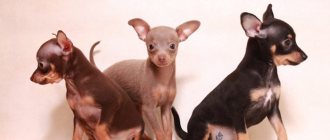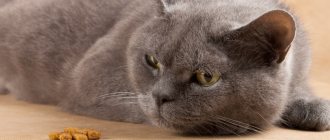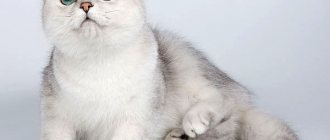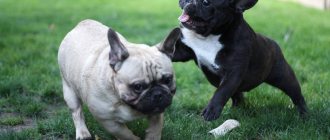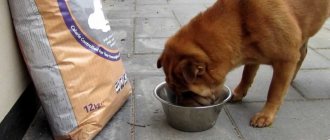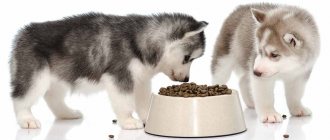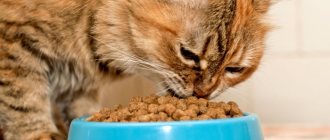Lots of opinions about what you can feed parrots
There are many different opinions on feeding issues held by ornithologists, feed manufacturers, veterinarians and bird behavior consultants. For example, regarding what food is suitable for large, medium or small parrots. Most of these opinions generate lively debate and can be very persuasive. But many of them contradict each other.
We often hear: “Seeds make parrots fat, and they should be excluded from the birds’ diet altogether.” And then suddenly we see an advertisement from a well-known company, convincing us that our bird can live to a ripe old age by eating this brand of fortified seed mixture. Or another statement: “Pellet feed is the only way to guarantee excellent health for your birds.” However, it is very difficult to get our birds to eat it. Or: “Apples and grapes are just sugary water and should not be given to your birds.” But on the other hand, these are still the same fresh fruits; how can they harm? What fruits and vegetables then can be given to a parrot, and which cannot? As a result, many questions arise.
Such statements can only confuse you, as you begin to doubt what you can give to your parrot. They also force us to rummage around for more information about what domestic or wild parrots eat. However, it is often too difficult to piece together disparate pieces of information into the best diet for our birds. Taking into account also the fact that parrots, even of the same species, have different preferences in food or feed.
Diet issues require some clarity. What is a balanced diet? What should be the composition of food for parrots? How can we make feeding more effective? What can we do to make our parrots more amenable to food? Why do they act so horribly about certain products? What goals are we pursuing by including new foods and treats for parrots in our diet? How can we make it all work together?
Hard food
The daily diet of parrots should include a grain composition. This is the basis without which it is difficult to imagine proper nutrition. When to pour food into the feeder (the daily norm once a day or add food several times a day) does not really matter, the main thing is that the parrot always has enough food, since they can do without food for no more than 24 hours.
Pet stores offer a wide selection of grain mixtures, ranging from the diet of budgerigars to large birds. Feed compositions vary depending on the size of the pet and its natural habitat. The following brands have proven themselves well: Italian Padovan, Belgian Versele-Laga, Italian Fiory, Russian RIO. When purchasing, be sure to make sure that the grain feed is tightly packaged and that its expiration date has not expired. Before pouring it into the bird's feeder, carefully inspect the grain to ensure there are no foreign impurities in it.
The nutrition of budgerigars or other species of these birds can be diversified by germinating the grain mixture. Sprouts are a storehouse of vitamins for parrots, which will have a beneficial effect on the functioning of your pet’s entire body. Please note that if you do not wait for the greenery to fully germinate (to the point of grass), but give a slightly hatching sprout, then such feeding provokes sexual behavior in birds. In addition to very young shoots, the bird also needs ordinary greens (nettle, lettuce, fireweed, dandelion). Greens from oats, wheat, and lettuce can also be grown on your windowsill.
When feeding Grays or other large birds, keep in mind that mixtures for large parrots already include nuts and seeds, so you should not offer them separately; use them separately only as a reward or treat.
Achieving Balance
Conditions
In fact, the answers to the questions are quite simple. I am convinced that parrots can balance their own diet, provided that we:
- We offer them a wide variety of fresh and natural products.
- We don’t give them foods that spoil their taste.
- We invite them to choose from what they are used to eating in nature.
- In general, we give them the opportunity to choose.
Research
About 20 years ago, laboratory studies were conducted on the dietary requirements of rats. It was found that, given a sufficient variety of fresh foods and the absence of foods that spoiled their taste, these rats could and did choose the most balanced diet for them at that time. In other words, they instinctively sensed what nutrients they needed at that time. And in accordance with this, they made their choice in favor of certain products. Of course, provided there are enough products to choose from.
Subsequently, even more fascinating studies were conducted among children. And most interestingly, it was again found that children also had the innate ability to independently balance their diet under the same conditions. A single child could eat exclusively broccoli for two days. Drink liters of milk for a few more days. Then eat exclusively whole grain bread. At the same time, he independently chose the amount of food that he needed at that moment to balance his diet. The only condition was that he had no access to products that spoiled his taste.
My experience
It is well known that foods that spoil the taste include foods rich in fats or simple carbohydrates (especially sugar), or both. The more “fast food” we eat, the more we want it. The more sugar we eat, the more sweet things we crave. And vice versa.
I remember that period of my life when I became very demanding about my own nutrition. At that time I followed a vegetarian diet. Mostly free of any fats or sugars. It was then that I happened to visit my husband’s relatives in South Dakota. I will never forget the disgust I felt when I saw a piece of meat floating in its own fat in a ceramic pot. My taste by that time had become relatively correct due to the diet I followed. And such a large amount of animal fats, of course, gave me a feeling of disgust. It's sad that if I were offered to try that dish again, perhaps I would try it now. Although at the same time I would experience a slight feeling of guilt. In general, in the end it all comes down to one thing again: a diet containing even a moderate amount of fats or sugars still spoils our taste to the extent that we choose foods that are not the healthiest for the body.
Scientific studies have shown that rats and children can choose the foods that are best for their health. What then can we say about what parrots eat in the wild? Given that these birds are hunted by many predators, a healthy body is an absolute necessity for them. Any kind of illness or illness will undoubtedly attract the attention of predators, and their life will then end. From this it becomes obvious that parrots are quite good at searching and choosing among local products those that allow them to most successfully balance their diet.
I often witness my own birds choosing certain foods over others depending on their current body needs. My pair of breeding Grays may eat little to no greens until breeding season arrives. At this time they simply attack her. Or another example: a parrot that has not eaten pelleted food for weeks suddenly eats every last piece of it in the feeder.
Vegetables, fruits, berries
For proper nutrition, your pets need vitamins and fiber, which are found in vegetables, fruits and berries. Not all birds want to eat them. But through trial and error, you can choose what your feathered friend will like. There is plenty to choose from:
| Fruits | Vegetables | Berries |
| Pineapple, apricot, cherry, grapes, banana, pomegranate, apple, pears, etc. | Beets, fresh cucumbers, sweet peppers, carrots, zucchini, cabbage, etc. | Strawberries, cranberries, blackberries, lingonberries, raspberries, etc. |
Did you know? Budgerigars are the most common ornamental birds; more of them live with people than in the wild.
Remember that it is preferable to give these fruits fresh and wash them thoroughly before feeding.
What spoils the taste and prevents parrots from eating properly?
I believe that our main goal is to provide our birds with as varied a diet as possible, including plenty of fresh food. And also containing the amount of proteins and fats necessary for this type of parrot. At the same time, an important condition is the absence of products that can spoil the birds’ appetite and prevent them from making the right choice. This brings us to the next question. What do parrots eat at home that spoils their taste?
Having carefully studied this question through the example of my own birds, I believe that the answer to it consists of two parts and is a case where we can only speculate, based on the above considerations. Products that spoil a parrot's taste:
- Contains more fat than a parrot would normally consume in nature.
- They contain more sugar than those that the parrot eats in its natural habitat. In some cases, salt can also ruin your appetite.
I often hear from owners of large macaws that their parrots prefer table food to anything else. In this case, the food we prepare for ourselves is what spoils the appetite of our birds. It so happens that the digestive system of our parrots best assimilates foods similar to those that the bird consumes in nature. And in the quantities in which she consumes them in nature.
Natural products in the diet of birds
Now a little about what is the best granulated food for medium, small and large parrots. I get asked about this quite often. A related question also often arises. Namely, what to feed the parrot if it runs out of pellet food. And should our pet eat such food at all?
If we want our parrots to make the right choices, we must give them the natural foods on which their diet in nature is based. This is the main reason I am against pelleted food. And it's not just about its monotony. By giving it, we in no way stimulate these energetic creatures such as parrots to make any choice. For them it is dead food. None of the ingredients in pelleted food are “live” or fresh. When we give a bird a fresh vegetable, every cell of that vegetable is alive and continues to function. Even though this vegetable has already been picked from the plant. The vegetable's cells will remain alive until it is cooked or frozen.
Natural foods contain fragile enzymes, plant-derived nutrients and a combination of nutrients in general that no pelleted parrot food can replace. That being said, I am not against giving pelleted food to birds. I feed my birds pelleted food, but I only do it on two occasions. I will dwell on this in more detail later.
It is very important what the owners feed their pet and what the parrot eats at home. I firmly believe that feeding birds a diet that is more than 50% pellets is foolishness! Especially considering that their body is biologically configured to process fresh food. In addition, we still do not know enough about the nutritional requirements of parrots to be 100% sure that pelleted food fully meets these requirements. As its manufacturers assure us. For example, not long ago there was an article in which an incident that happened with a macaw chick was mentioned. He suffered from a disease called perosis, expressed in the curvature of the legs. This chick was 100% pelleted fed. Which turned out to be too low in choline. Adult birds can produce choline themselves, but young birds must obtain it from their diet.
What do parrots eat at home?
In captivity, birds are deprived of freedom of choice and are forced to eat whatever the owner offers. To maintain the health of your pets and provide them with the necessary substances, food for parrots should be selected thoughtfully, without trying to save money.
One of the best foods for a pet parrot is considered to be a grain mixture produced by a company with a good reputation and packaged in high quality. This diet is as close as possible to the healthy food consumed by free birds, and it is also enriched with minerals and vitamins. But it’s boring to eat food from a pet store alone: just like humans, birds want to feast on a variety of tasty treats.
Store-bought feed
The range of mixed feeds produced for parrots is not particularly large, but you can still choose the appropriate composition. You just need to understand that small birds will not be able to eat what is intended for large ones - they simply will not swallow the grain. Mixtures that are produced on an industrial scale contain different types of seeds and cereals, cereals, and crushed nuts. It is not uncommon to find dried vegetables, fruits, leaves and even honey in store-bought food.
We recommend reading: Can parrots and cats live in the same apartment?
The bird food market offers the following types of mixtures:
- Cereal mixture with minerals is Chika's cheap food for budgies. Most of the box is occupied by millet; flax, canary and hemp seeds, and crushed oats are also present. The daily intake rate for young and mature birds is up to two tablespoons.
- The highest quality product is known under the Italian brand Fiori - this food for parrots is very popular. Each batch of the mixture is packed in a vacuum bag, which has a positive effect on the safety of the feed. Inside it contains seeds and grains, vegetables and cereals, corn kernels and even raisins. The most selective pet will find ingredients to suit his taste
- Most often on the shelves of pet stores you can find food produced by Rio. The Russian brand produces mixtures for small, medium and large species of parrots. The products are packaged in two versions: diet for every day and for molting periods. The “cocktail” for large birds includes a dozen grain crops, dry berries, algae, peanuts and other delicacies.
- Padovan is imported from Italy - food for large species of parrots, which does not lose its beneficial properties for a very long time. The grain is thoroughly cleaned of impurities, and the sealed packaging protects the mixture from humid air. The rich composition of the product allows you to fill the bird's diet with valuable nutrients: there are cereals, crackers, fruits, and mineral supplements.
Hard food
If the parrot often has food left over, or the bird scatters it around the cage, it means that the treat was not to his liking. You can experiment with a beginner by offering him grain compositions from different manufacturers. You don’t have to buy formula, but prepare the food yourself. This, of course, is a troublesome matter, but what will you do for your picky pet!
The basis of a bird’s daily diet should be grain feed, which is approximately 80% of the total mass of food consumed.
Important! You should have separate feeders for parrots: one for grain, the other for wet foods. This way the dry mixture will not get wet and spoil. This will protect the birds from eating rotten food and diseases of the digestive system.
As a reward for a learned word or a demonstrated trick, a smart bird is given chumiza - this is a delicacy, not the main food. Just as people should limit their consumption of sweets, you shouldn’t overdo it with chumiza for parrots: no more than two stems per week.
Some parrots particularly like millet - it's an unprocessed millet grain, so why not use yellow millet? Thinking about whether it is possible to feed a tame parrot with millet leads to a positive conclusion. Millet is a healthy product necessary for the proper growth and development of poultry. It has a pleasant taste, so it is usually eaten with pleasure by parrots.
We recommend reading: The most expensive and rare species of parrots
Fruits and berries
You just want to treat your pet to ripe fruits, but here it is important to stop and ask which fruits and berries can be eaten by parrots, and which will only be harmful. A list of tasty and juicy treats that will benefit your parrot:
- a pineapple;
- apricot;
- pear;
- apple;
- plum;
- feijoa;
- peach;
- quince.
You can give imported apples to your parrot, but before doing so, you should cut off their peel, which contains harmful chemicals. A sweet orange without skin and seeds will delight medium-sized birds; it is not advisable to offer this fruit to small parrots. Not everyone likes citrus fruits, so when asked whether it is possible to give tangerines to parrots, the answer will be obvious: either the bird will peck at the juicy pulp or will refuse.
You should not give parrots persimmon, mango, avocado and papaya - these fruits contain esters and tannins that have a detrimental effect on birds. Is it possible to feed parrots bananas? Yes, they treat this delicacy with great respect, just like grapes, melon, and kiwi. You shouldn’t get too carried away; excessive consumption of sweet and high-calorie foods will not lead to good.
It is a difficult question whether parrots can peck pomegranates, because they contain many seeds. If there are no liver diseases, then pomegranate seeds in small quantities will not harm the parrot.
There are many options for what you can give your parrot to eat if there is no specialized food: fresh vegetables, fruits and berries, taking into account contraindications.
Vegetables and greens
Juicy food must be in the diet of any parrot. Seasonal vegetables and herbs will add variety to the menu, provide nutrients and enhance digestion. Birds may ignore the offered vegetable cuttings, but don’t give up, keep experimenting. You can cut out figures for your parrot from a bright pumpkin or grate carrots and put them in the feeder.
Sometimes novice breeders have doubts whether it is possible to give cabbage to a parrot, whether it will cause gas formation. Any variety of cabbage is useful for feathered chatterers, only the leaves must be doused with boiling water and finely planed. Boiled vegetables lose most of their vitamins, and birds are not accustomed to such food. Fresh cucumbers, zucchini, bell peppers and beets are a great addition to your regular diet. In winter, you can cultivate greens and parsley on the windowsill for parrots, as well as oats and wheat from sprouted grains.
Nut mixes
Often nuts are bought as a treat for feeding a pet parrot. This is heavy, fatty food, it is poorly digested by the bird's stomach. If you really want to treat your pet, it is better to take pistachios, sweet almond kernels and pecans. But just don’t salt it, don’t fry it, but offer it raw and in a minimal dose. Due to their high energy value, these nuts are very useful for large species of parrots.
Imported factory mixtures contain large quantities of unshelled peanuts, which can cause mycosis in birds.
Porridge
Dry cereal is, of course, healthy, but sometimes you can treat your pet with porridge. It will seem tasteless to a person, because it contains neither salt nor oil. But the bird will be delighted with crumbly porridge mixed from various cereals and legumes: buckwheat, brown rice, lentils. Such food should not become daily food for a parrot; it is a kind of lifesaver when the purchased mixture suddenly runs out.
We recommend reading: Perches and perches for parrots
Sprouted food
In addition to dry grain, sprouts are sometimes added to the feeder. This treat should interest the birds, but moderation is important here: an excessive amount of eaten sprouts awakens the reproductive instinct. If you don’t plan to mate birds and raise chicks, you need to figure out something tasty to feed your parrots, instead of sprouted grains.
Twigs
House talkers love to play with branches, sharpen their beaks and claws on them, but they are not averse to feasting on the tender young bark of a tree. Caring owners will never forget to put several sprigs of rowan or cherry in the cage, which parrots eat with particular pleasure at home. Cut shoots should first be washed with soap and scalded with boiling water.
It is unacceptable to give a parrot:
- pine paws with resin;
- bird cherry and oak;
- poisonous lilac and acacia;
- poplar is an air sanator (actively absorbs toxins from the atmosphere).
You cannot cut off trees growing near highways - their branches and fruits are extremely toxic due to exhaust gases.
Animal feed
There are situations when you need to quickly feed your parrot something if you run out of food. Despite the fact that parrots eat grass and grain, in nature they are not averse to snacking on insects, caterpillars, and bugs. Animal proteins are sometimes simply vital for them. There is always some kind of human food in the house that can be offered to the bird.
After examining the contents of the refrigerator, a person wonders whether it is possible to give the parrot low-fat cottage cheese. Ornithologists answer this question in the affirmative. In addition to cottage cheese, yogurt, kefir and natural yogurt (without fruit and other food additives) are suitable for consumption. It is better to give treats from a spoon rather than putting them in a feeder or drinking bowl.
It is useful to occasionally feed growing individuals with boiled chicken or quail eggs. Both the yolk and white are edible, but only a boiled egg should be offered to parrots no more than once a week. And for adult birds, especially single ones, it is generally undesirable to eat this product, otherwise their sexual instinct will be triggered.
We recommend reading: The largest parrots in the world
Vitamins and mineral supplements
During plumage change and in winter, vitamins are especially important for parrots. There are not enough of them in food, so you can replenish the balance with the help of complex supplements. Beaphar vitamins in liquid form are an excellent supplement. It is suitable for small, medium and large parrots. The dosage is selected depending on the weight of the bird. The method of application is simple: just pour the required amount of solution into the feeder, into the food mass.
An excess of vitamins is as harmful as a deficiency, so it is very important to follow the recommendations of ornithologists and feed the birds in courses - every two months for two weeks.
In zoological stores you can buy a special mineral mixture called Rio, which contains several components that are important for the proper functioning of the stomach and internal secretion organs:
- shell rock;
- White stone;
- Red stone;
- pine nut shell;
- Cambrian clay;
- charcoal.
The mineral mix should be poured into a separate container, secured in the cage and changed as it gets dirty.
Regular chalk serves as a source of calcium for parrots. It strengthens bones and makes eggshells hard. In addition to chalk, you can use a mineral stone, which the bird will gradually chisel with its beak until it disappears completely.
An original delicacy – honey sticks. They can be purchased at the store, or you can make them yourself at home. To do this, you will need to mix flour with honey water to the consistency of a paste, coat several wooden sticks with the mixture and sprinkle them with fine grain. Dry for 24 hours, pour honey over it and leave for some time to harden. You can occasionally pamper your pet with a ready-made sweet toy.
Drink
For normal functioning, any body needs fluid. Doubts arise about what kind of water to feed a parrot so that it is beneficial. Water suitable for parrots is unboiled, filtered or bottled. Water poured from the tap must be allowed to stand to remove chlorine, after which it must be passed through a carbon filter. Only in this case it will not harm the birds.
The drinking bowl should be washed daily and fresh water should be poured into it. To avoid intestinal diseases, the condition of food containers in the cage must be monitored especially carefully.
We recommend reading: Which parrot is best to have in an apartment
Can a parrot have bread?
Bakery products consist of flour obtained by grinding cereals, which is exactly what parrots eat. This fact may suggest that bread is very useful for birds. But in addition to the flour component, bread contains salt and yeast. In the stomach of feathered birds, the crumb swells and causes heaviness, fermentation, and malaise. Rye bread is especially harmful; it can cause colic and also inhibits intestinal microflora. If you are wondering whether it is possible to give bread to parrots, treat your pets to a cracker.
Different dietary needs
It is very important to know what parrots eat in their natural habitat, that is, in the wild. We must also recognize that different species of parrots have adapted to live in different regions of the world and eat local foods. In addition, they have developed their own feeding habits. Should we feed grays the same thing we feed blue-and-yellow macaws? Grays' ancestors adapted to live in Africa near the equator and eat on the ground. Macaws, in turn, live in the humid jungles of South America and usually eat almost nothing on the ground. So should you feed them the same? I guess not. And this fact negates so many of the generalizations we hear about feeding parrots.
Part of the diet of birds that feed on the ground in the wild, such as Grays, cockatiels and cockatoos, consists of seeds of various plants. Parrots eat the seeds that fall to the ground when ripe. Because of this, I believe that a partial inclusion of seeds in their diet is acceptable for these birds. What then is the best food for these types of parrots and in what quantity? The answer is: for my birds, I create a diet that consists of 10-15% seeds.
On the other hand, most macaws, Amazons and birds of the genus Pionus, along with parrots from the New World, feed under the cover of the humid jungle. They usually do not come down to the ground to feed on it in the same way as Grays. Their diet naturally contains fewer seeds. And these are the types of birds that often develop aggression, as well as problems due to obesity, if in captivity their diet largely consists of seeds. What do people who know this dietary feature usually feed such parrots at home? These bird species in my house receive a strictly limited amount of seeds. And to compensate, I add even more nuts and other fruits to the variety of fruits and vegetables they get in their diet.
Grain mixture for feeding:
- Millet is the main component of the diet of parrots
- Oats
- Sunflower seeds (raw, not roasted).
It should be noted that parrots can eat the seeds first, and leave everything else for later; you should not add them again, because sunflower seeds are very oily and eating them en masse can cause metabolic disorders. Let the bird finish the rest of the grain mixture, then pour it in again. As they say, a little sweet. Make sure that the bird eats all the food.
Grains in the diet
Also, you need to pay a little attention to the choice of oats; it can be peeled or unpeeled. It is better to eat unrefined grains. Firstly, the shell will retain more useful substances in the grain than in the peeled grain. Secondly, your parrot will have an additional activity.
One cannot help but mention sprouted grain. In addition to dry, it is recommended to include sprouted seeds in the diet, especially in the winter. Sprouted grain has many useful and necessary substances that are not found in other types of feed.
In order to germinate grain, take a tablespoon of grain and pour hot water, after an hour and a half, you can give the food to the parrot. Please note that sprouted grain quickly deteriorates, so you should not soak it in large portions and you need to promptly clean the cage of uneaten food.
Fruits and greens in a parrot's diet
This is the basis of a healthy diet. But, besides this, the parrot can be fed fruits and various greens. These can be ordinary apples, plums, pears, strawberries, pumpkins, carrots or beets, or some exotic fruits: mango or kiwi. With this you can add some variety to your diet.
With a variety of greens, you can choose young dandelions, green salad, parsley, dill, sorrel, young nettles.
It is necessary to ensure that all of the above fruits and greens are grown in environmentally friendly conditions, because the fragile parrot’s body can very poorly tolerate the presence of pesticides and other bad substances in its food. Ecology comes first!
Animal proteins
The modern parrot is satisfied with more than just grains and greens! In addition, it is also possible and even necessary to feed parrots with animal proteins. Such foods include boiled chicken eggs and cottage cheese. A boiled chicken egg can be grated together with beets or carrots, and in addition add crushed dry nettle as a “seasoning”, to do this you need to dry it during the summer, and you will get this “parrot salad”. Monitor the suitability of such a product!
Food from a pet store
An alternative option is purchased food from pet stores. They contain a variety of grain mixtures, parrot crackers and sticks. When choosing them, pay attention to the date of manufacture and the presence of various additives and dyes. You shouldn't skimp on maintaining your talking friend. In my opinion, it is better to get by with “homemade” food if you eat it correctly. And if you decide to use store-bought food, do not buy too cheap, consult with the seller.
Water for birds
An indispensable attribute in a parrot's cage is a drinking bowl. Water is necessary for these beautiful birds, because grain contains a minimum of moisture, and all living things, as we know, consist mostly of water. Change the water in the drinking bowl often. It is better to use unboiled water, because there is very little oxygen left in it. Buy it in a store or pass it through a special filter for cleaning if you doubt its quality, and it’s better to be safe.
Add some sand to the bottom of the cage. Your pet will peck at it a little, because sand is necessary to ensure the bird’s normal digestion process.
Feeding in winter
In winter, when there are very few vitamins, everyone is sick and sitting at home, it is recommended to add a little lemon juice to the water, it contains a lot of vitamin C, which strengthens the immune system, everyone knows this. Also, in winter, you can give vitamins that can be bought at a veterinary pharmacy, and do not forget about dried nettle with a boiled chicken egg.
And the last recommendation for feeding a parrot is to change its feeder daily, blow off yesterday's husks and add new food. Try not to overdo it in feeding - the parrot lives in an apartment, not in the wild, therefore, it moves much less, often, some do not even know how to fly, overfeeding leads to excess weight, from which nothing good can simply happen.
Visual experience and its influence on bird nutrition
Finally, we must understand how parrots eat and what factors influence their eating habits. This is necessary in order to correctly determine the possible reaction of birds to the diet offered to them. Whenever I discuss the topic of bird feeding with parrot owners, I almost always hear the same answer. “But I can’t feed him broccoli (or carrots, or wild rice, or greens...). He doesn’t like it!” Apparently the bird's owner tried giving it broccoli a couple of times and then stopped based on the fact that the parrot wouldn't eat it. This interpretation of the parrot's behavior is incorrect and is based on two things.
Firstly, starting from the statement that a parrot can balance its diet itself, it is necessary to understand that at some point in time, simply due to lack of appetite or due to the fact that at that moment it feels the need for other foods, the parrot may refuse to eat anything. And based on this, we cannot interpret our parrot’s reaction to this product as evidence that “he just doesn’t like it.”
Secondly, it is important that we understand that a parrot's own visual experience often dictates whether it will eat something or not. Parrots perceive everything by their appearance. I believe that in nature, adult birds teach young, barely fledged parrots to choose their food in the following way: “LOOK. You should eat something that looks like this.” And not: “Here. Take it. Try it. Eat any plant you like, like this.” Because in the latter case, the young parrot would be in danger of trying a poisonous plant in search of an edible one. Although it is obvious that parrots like the taste of certain foods, it is scientifically proven that the number of taste buds on the tongue of parrots is significantly less than that of humans. That is, taste sensations are not the main thing for them.
And also about what domestic and wild parrots eat. These birds are terrible conservatives. If I hang a feeder outside in a new location, it will be at least two weeks before wild birds are anywhere near it. First, they must get used to the sight of the feeder and realize that there is food for parrots there. Therefore, when offering new food to parrots, we must also assume that our feathered friends will most likely not eat it for some time. This happens simply because in the beginning they have to get used to its appearance.
Multilayer mixture of fresh vegetables and fruits
If you have time to prepare it, you can provide your birds with a complete diet.
Every week I dedicate a couple of hours to making this layered mixture of fresh vegetables and fruits for my parrots. I then store it in airtight plastic containers. Their size and number depend on the number of birds that live with you. The mixture consists of several layers, which are arranged in the following order (listed starting from the bottom):
- Finely chopped greens (chard, mustard greens, fresh herbs, sorrel, cilantro leaves, parsley, kale, carrot greens, endive salad, etc.).
- Finely chopped vegetables (celery, bell peppers, pumpkin, cucumber, sprouts, cauliflower, zucchini, grated carrots, beets, green beans, etc.).
- Broccoli in small pieces: either fresh or boiled for 5 minutes.
- Lightly boiled and cut into small pieces vegetables rich in vitamin A (pumpkin, yams, carrots, etc.).
- Pasta (dry) made from whole grains.
- Boiled Legumes (Soak overnight, then cook for 20 minutes) You can use a ready-made mixture of 17 types of legumes or create a mixture of your own choosing. Soybeans, as well as popular soak-and-boil mixtures, must be cooked separately for at least an hour. (To help the mixture keep better, you can freeze the boiled beans in individual bags (one bag at a time) and add them after thawing to the mixture in the morning when feeding the birds, instead of including the beans in the puff mixture immediately after cooking).
- Fresh corn on the cob (cut first into small rounds and then into quarters) - if in season.
- Finely chopped apples.
- Finely chopped citrus fruits.
- Whole grapes (possibly with seeds).
- Mix of frozen vegetables.
If you lay the layers in the above order (citrus fruits - the penultimate layer and frozen vegetables - the last layer), then, if necessary, you can keep the mixture fresh for up to 4 days or more.
When I need to use a mixture, I usually pour the contents of the container into a large bowl and mix all the ingredients thoroughly. Also, at the same time, I often add 1-2 more new ingredients, such as juicy fruits, for example (plums, peaches, watermelons) and ready-made (sprouted or boiled) cereal grains. I then put 8 parts of this fresh mixture in another bowl and add one part high quality seed mixture and one part kibble food. I mix all this thoroughly and place it in feeders. Each bird receives 2/3 to 1 heaping cup of this mixture twice a day: in the morning and around 5 o'clock in the afternoon, which corresponds to their feeding time in the wild. The mixture prepared according to this recipe consists of 80% fresh vegetables, fruits, pasta and legumes, 10% seeds and 10% granular food for large, medium or small parrots.
Ready mixes
Budgerigars love ready-made nut and grain mixtures. Everything is clear with grain, the mixture can consist of corn, oats and wheat, rice mixed with millet. It is more difficult to make a nut mixture yourself, primarily because some types of nuts are contraindicated for budgies and any other representatives of the species.
Mixtures containing pistachios, pecans, sweet almonds and madacamia, and peanuts (need to be peeled) are considered ideal in composition and taste.
There are many advantages
Expiration date
The proposed mixture-based diet has many advantages over others. This is what you can, and what I recommend, feed parrots in addition to (or better yet, instead of) food. The mixture can be left in the feeder for a long time. Since most of the ingredients in the mixture are given raw, and the mixture itself is relatively dry, it does not create conditions for rapid growth of bacteria. As is often the case with other legume-based or chopped vegetable and fruit mixtures, due to their excessive moisture.
Possibility to choose
The mixture also leaves the parrot with a choice: he eats in proportion to his appetite and the nutritional needs of his body. We must do everything possible to provide freedom of choice and freedom of movement for our birds. That is, give them those two things that they first of all lose when they fall into captivity. We must do everything possible to somehow make up for their lost freedoms.
Diversity
And one more advantage: preparing the mixture is a creative process. There is no end to the variations of this mixture. Once a week I change the composition of one of the layers. I choose other types of greens and other vegetables to cut. I can use lemon and kumquat instead of orange in the citrus layer. I can replace the grapes with blueberries and/or cherries (pitted). Use red bell peppers instead of green bell peppers. Vary the shape of the pasta you use: one week I give you tiny letters or stars, another week I give you wheels.
Each morning I stir the mixture and add other foods to provide even more variety to my diet. This could be canned peas (chickpeas), sesame seed sprouts or other seeds, lightly boiled grains of cereals or other plants (brown rice, millet, amaranth, quinoa), carambola, lightly chopped nuts (Brazil, almonds, walnuts, etc.). d) or pieces of toast with a thin layer of peanut butter. I may use small canary seed instead of a seed mixture for larger parrots. I can choose another granulated food for feeding parrots. In general, there is no end to the variety. My birds never know what awaits them at the feeders and rush to them with all their might to find out.
Way to switch
One more thing: this mixture is the fastest way I know of switching birds that are used to eating exclusively seeds to fresh food and pelleted food. I give this mixture to a wide variety of birds, both wild-caught and hand-fed. And even to abandoned birds who are accustomed to living exclusively on seeds.
There is not a single bird that is not quickly tempted to try the mixture. Because Ultimately, the mixture contains 10% seeds, very little effort is required to persuade even the most inveterate stubborn person to accept it. While choosing seeds from the feeder, the parrot also tastes and eats pieces of fresh food. The parrot does not suffer from hunger, because... eats seeds. And soon he gets used to fresh food. For particularly stubborn birds, I add an extra tablespoon of seeds to each feeder until they get used to the mixture. It is also important that since the mixture consists of 10% granulated food, those birds that have not previously eaten dry granulated food at all begin to eat it as part of the mixture.
Health
This mixture allows parrots to be beautiful and healthy birds. Once, after molting, I saved the feathers of rejected birds, and then compared them with the feathers of the same birds a year later this week. The difference was obvious and impressive.
Discontent
Only once did I hear a dissatisfied response regarding this method of feeding. The owner was unhappy that too many fruits and vegetables from the mixture ended up at the bottom of the cage. However, it is necessary to understand that parrots are designed this way. This is their usual way of eating - take a piece of food, bite off a little of it and throw away the rest.
I have been puzzled several times by clients who say, “my chick won’t eat anything.” My bewilderment was caused by the fact that the chicks ate with appetite at my house and were on a similar diet at theirs. But upon further questioning, it turned out that the chicks fed in their usual manner, described above. And due to the fact that a lot of food ended up at the bottom of the cage, the new owners worriedly thought that the chicks were not eating anything at all. All parrots behave this way in nature. Thanks to them, fallen food acts as a nutritious mulch for plant seeds and helps ensure their germination. And ultimately promotes the flourishing of lush vegetation in the parrots' habitat. Those who can't stand losing parrot food can use it for chickens or to form compost.
Budgerigar menu: basic nutrition
Australian budgerigars, when in their natural environment, eat everything. They like the seeds of herbs and cereals, tree buds, and some insects. They love to eat berries and fruits. Seeds of varying degrees of maturity are the main food.
Wild birds instinctively know the needs of their body, and the domestic budgerigar is under the care of its owner. Without the right food, your pet can lose its immunity and get sick. When buying a bird, you need to have an idea of what to feed the parrot when it arrives at your home.
Hard food
What to feed budgies if not grain food? Grain in the diet is the main one and makes up 1⁄2 part of the rest of the feed. The amount that birds eat is 2 tsp. grain mixture for a day, the basis of which is oats, millet and canary seed. Other seeds may be present in the composition, but you should not add fried sunflower seeds, which can poison your parrot.
The bird should eat the mixture gradually and completely, without selecting its individual components. The parrot has the habit of carefully cleaning the grain, removing the shell and choosing the seed it likes.
The grain mixture should be added as needed to ensure that the feeder does not remain empty. The food is dry, so you need to constantly add fresh water to the drinking bowl. This is bottled or filtered water, but not boiled.
Often, owners prepare sprouted grain food, which parrots readily eat. This is a nutritious and vitamin product with excellent digestibility. The mixture intended for soaking consists of a variety of seeds and is more complex in composition. The need for it before the first molt is 1 tsp. twice a week, and then 1 tsp is enough as a weekly norm.
The grains are sprouted in one go, since the product is stored for only 48 hours in the refrigerator, after which a fresh portion of grain is needed.
Sequencing:
- the grain is thoroughly washed;
- lay out in a 1 cm layer in a flat container;
- the base is first lined with cloth;
- the grain is covered with the same layer of fabric;
- pour water so that it hides the grains;
- leave in a warm place for germination;
- Periodically add drying water.
After 1-2 days, the grain sprouts up to 3 mm and is ready to be fed to birds.
Budgerigars eat cereals that are not only nutritious, but also rich in dietary fiber and microelements.
They are useful for metabolism in the bird's body. They are prepared in water; the cooking process lasts 10 minutes. Instead of cooking, the grain can be steamed for 30 minutes by pouring boiling water over it and covering the saucepan with the cereal mixture.
The following compositions are used: buckwheat/oatmeal/rolled oatmeal/lentils or barley/corn/wheat/rice mixture. 2 tsp per parrot. porridge, which birds eat warm. Porridge is prepared three times a week, but sometimes we can do without it.
Note: A set of grain food is sold in pet stores. When purchasing, you must check the packaging for leaks. After opening the package, you should pay attention to the appearance and smell of impurities and mold. It is better to choose food in cardboard packaging rather than thick plastic packaging.
Fruits and vegetables
“Fruit and vegetable salads” are introduced into food for budgies as an accessible source of vitamins. Vegetables and fruits are placed under the grill and wait for the parrot to pay attention to the tasty food. Birds eat them in the form of chopped or grated pieces.
The following vegetables are not given to birds:
- onions, garlic because of the sharp, pungent taste;
- radish, radish, daikon, celery, which have a strong taste;
- eggplant due to the presence of the toxic substance solanine.
Mango, avocado, papaya, and persimmon should be excluded from the fruit set that can cause poisoning in birds. Nuts contain a lot of fat and can disrupt the digestion of birds, so pets are rarely allowed to eat them. Only as a delicacy they offer a few pine nuts or a little walnut.
The diet of budgerigars should contain only fresh food. Yesterday's leftover food should be removed, the feeder should be thoroughly cleaned and the next portion should be added, roughly approximating how much the birds eat during the day. Parrots in cages are constrained in movement, so it is dangerous to overfeed them.
Important! Birds need environmentally friendly products. The content of toxic chemicals and pesticides leads to poultry poisoning. To avoid possible complications, the fruits should be peeled, since the peel contains the most harmful impurities.
Greenery
You should definitely include fresh greens in food for parrots, but not in armfuls, since mown or cut grass may contain a poisonous plant. It is not advisable to pick grass along roadsides, on city highways or in crowded parks where it is heavily polluted.
The list of permitted herbs is huge, but there are exceptions. You should avoid basil, St. John's wort, cilantro, buttercup, parsley, tansy and other strong-smelling or poisonous herbs. In winter, you can add dried nettle to the food or grow microgreens on the windowsill, which birds eat with pleasure.
To increase the choice of a “green diet,” indoor flowers are used. The bird is offered to peck the leaves of some crops. If the parrot flies freely around the house, then you need to get rid of or cover up poisonous indoor plants. You cannot offer birds store-bought flower arrangements: they are treated with various chemical components.
Prepared bean mixture
Compound
Another mixture that I regularly prepare for my birds and give to them every other day, usually in the afternoon. I remove this mixture before going to bed, because... Cooked foods spoil too quickly. The main components of the mixture are as follows:
- 1 cup quinoa (the leaves of the plant contain a lot of calcium and protein, they can be bought at all health food stores);
- 2 glasses of water;
- 0.5 cups grated nuts (Brazil, almonds or walnuts);
- 2 cups grated yam (or other vegetables high in vitamin A);
- fresh kernels of hulled corn from two ears of corn or 1 cup of frozen corn;
- 0.5 cups canary seed;
- 1 cup grated green vegetables;
- 0.5 cups uncrushed sesame seeds (from a health food store).
Cooking method
Boil water and add quinoa. Bring the water back to a boil, cover, reduce heat and simmer for 5 minutes. Add the yams, cover again and cook for another 10 minutes or longer. Until all the liquid is absorbed. Place the mixture in a bowl, add the remaining ingredients and stir lightly. Serve the mixture slightly warm.
You can add variety to this mixture by using different grains instead of quinoa (but this may increase the cooking time), carrots, pepo squash or pumpkin instead of yams, and changing the composition of green vegetables and nuts.
Cornbread
And one more, third mixture. Twice a week I give the birds cornbread. I use the standard cornbread recipe. At the same time, I buy corn for him (uncrushed) only at a health food store, as well as whole grain flour. You can add any number of ingredients to this mixture, including grated vegetables and fruits, sesame seeds, pumpkin seeds, raw sunflower seeds, creamed corn, grated low-fat cheese, green chili pieces, etc. There is no limit to the number of products that can be added to the main ingredients of the mixture. Thereby introducing even more variety into your parrot’s diet.
Vegetables
Vegetables are no less useful. The daily menu of an adult lovebird should contain no less vegetables than fruits. Many birds simply love:
Fresh carrots (the tops don’t need to be torn off, the birds eat them too, not disdaining even slightly dried greens.
Sweet and even hot peppers are eaten together with the seeds, the main thing is to make sure that the vegetable is well washed and does not contain signs of disease (mold, black spots, rot).
Tomatoes and cucumbers.
Rutabagas, turnips and turnips are pre-blanched.
Squash, pumpkin, squash and zucchini can be given directly with the seeds.
Beetroot and beet tops.
Brussels sprouts and kohlrabi, scalded with hot water.
Celery, green peas and beans in pods (need to be blanched).
Broccoli and cauliflower (vegetables are kept in boiling water for 3-5 minutes).
The lovebird parrot will not refuse a fresh ear of corn, especially sweet sugar varieties. Half the average size of an ear of cob per day is enough to satiate. At the same time, corn can be used not only for satiation, but also for games, entertainment is guaranteed for both it and the owner.
In the summer, the parrot is fed leaves of young nettles, spinach, lettuce, honey and plantain. Greens contain all the vitamins a bird needs; the main thing is to collect it correctly. It is advisable to do this away from roads and any sources of dust pollution. Before distribution, the leaves are treated in hot water and crushed. You can add greens to porridge or grain mixture.
Treats or seed treats for parrots
You will need:
- 2 tablespoons peanut butter;
- two tablespoons of honey;
- one egg;
- 1 sachet of gelatin without flavoring additives;
- liquid vitamins for birds (optional);
- 2 cups of seeds and/or granulated food (some of the seeds can be replaced with oatmeal or corn flakes, dried fruits or nuts).
Mix all soft ingredients in a bowl: peanut butter, honey, egg, gelatin, vitamins (if available). Make sure the gelatin has completely dissolved. After this, add all the dry ingredients (seeds, flakes, dried fruits, nuts), mix well and knead until smooth. Then either form into large flat balls and place them on a lightly greased baking sheet or place the entire mass on it at once, while the layer thickness should be no more than 1 cm. In the latter case, cut the layer before putting it in the oven into small squares. Bake at low temperature - no more than 150 degrees Celsius until done. As soon as the mass hardens and becomes golden in color, it is ready.
Place for granulated feed
As I mentioned earlier, I believe that pelleted food can be a healthy part of your parrot's diet. Each of my birds has free access to a feeder with granulated food, which I give twice a day in addition to the above mixtures. It doesn't really matter to me whether birds eat pellets or not. However, I find it clear that if parrots are offered the kind of pelleted food that birds of their species generally prefer, and given a choice, most of the food (depending on appetite) will be eaten by the birds. There are periods when birds completely eat all the granulated food. I throw away the remains of the granulated food, as well as the remains of the mixture.
I do not use heat-pressed kibble that contains chemical food coloring. And I don’t understand the rationale for using it at all. Especially considering publications that such products have caused exacerbations in hyperactive children. I believe that “the court has retired to deliberate” on this issue and prefer not to risk giving this food to my parrots. I usually use brands of kibble like Harrison's; Breeder's Blend; Foundation Formula and Scenic Diet. I have found that my Grays prefer Harrisons' High Potency blend, which is designed for birds with higher dietary fat requirements. My cockatoos prefer Scenic Diet. Macaws, Amazons and Pionus love Breeder's Blend and Foundation Formula.
Each bird receives a separate feeder with the granular food it likes. I also include these four types of pelleted food listed above in a mixture of fresh vegetables and fruits so that the birds have the opportunity to try the other three mixtures that they do not have in their cage. In addition, the granulated food included in the mixture absorbs moisture. I also noticed that some parrots prefer to eat it softened rather than dry.
Soft food for parrots
Soft (protein) food is given to parrots while raising chicks and laying eggs. However, amateurs say that such food should be given to parrots in small quantities throughout the year. Such mixtures can be bought in stores. They contain a lot of protein, so such food has a good effect on the appearance of your feathered pet. You can prepare soft food yourself. To do this, you need to soak white bread and rolls in water (milk). Then this mass should be squeezed out well. To increase the nutritional value of the mixture, you can add additional components to it: glucose, baby formula, crushed egg shells, wheat germ. If you add a boiled egg to such a mixture, the amount of protein in the mixture will noticeably increase. It must be remembered that it is necessary to prepare such a mixture only for one feeding. The prepared mixture can be in the feathered pet’s feeder for no more than three to four hours.
Allergies and other reactions of parrots
Before closing this topic, I would like to make a few more caveats. It is always necessary to take into account that parrots can react painfully to certain types of fruits and vegetables. Or due to the use of fertilizers when growing them. Or on chemical additives in some products. It is currently unclear whether the nature of these reactions is an allergy or some other predisposition. Therefore, while offering a variety of foods to our birds, we must also pay attention to possible changes in their behavior that may serve as an indicator of such problems.
Not long ago, one of my clients called me, whose Amazon began to speak as if in a drawl... And constantly. Knowing how unnatural such a sudden change in vocalizations is for birds, she took the bird to a veterinarian, who discovered significant inflammation in the gastrointestinal tract. This was the reason for the funny sound of the bird's voice. At that time, this woman was feeding her Amazon strawberries, something she had never done before. Whether such a reaction in the bird’s body was caused by strawberries or due to the use of fertilizers when growing them, no one knows. However, it is obvious that such a reaction is unnatural for birds. Therefore, we must always be aware of the danger that some products may pose to them. We must carefully monitor what our birds eat and know what we can feed parrots at home.
